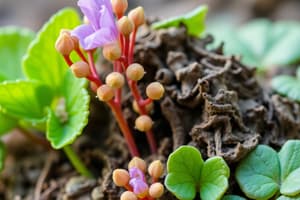Podcast
Questions and Answers
What is a population?
What is a population?
A group of individuals of the same species living in the same area at the same time.
What is a biological community?
What is a biological community?
A group of different interacting populations that occupy the same area at the same time.
What is an ecosystem?
What is an ecosystem?
All of the living (biotic) and nonliving (abiotic) things interacting in an area.
Put the levels of organization in order from smallest to largest: ________ , biological community, ecosystem.
Put the levels of organization in order from smallest to largest: ________ , biological community, ecosystem.
What is a limiting factor?
What is a limiting factor?
What are some examples of limiting factors?
What are some examples of limiting factors?
What is the importance of limiting factors?
What is the importance of limiting factors?
What does density-dependent limiting factor mean?
What does density-dependent limiting factor mean?
What are some examples of density-dependent limiting factors?
What are some examples of density-dependent limiting factors?
What does density-independent limiting factor mean?
What does density-independent limiting factor mean?
What are some examples of density-independent limiting factors?
What are some examples of density-independent limiting factors?
What does RANGE of tolerance mean?
What does RANGE of tolerance mean?
In biology, what does tolerance mean?
In biology, what does tolerance mean?
In a range of tolerance, what does optimum zone mean?
In a range of tolerance, what does optimum zone mean?
In a range of tolerance, what does zone of physiological stress mean?
In a range of tolerance, what does zone of physiological stress mean?
What is carrying capacity?
What is carrying capacity?
What kinds of things limit carrying capacity?
What kinds of things limit carrying capacity?
What is exponential growth?
What is exponential growth?
What shape is the line in an exponential growth graph?
What shape is the line in an exponential growth graph?
What is logistic growth?
What is logistic growth?
What shape is the line on a logistic growth graph?
What shape is the line on a logistic growth graph?
Flashcards are hidden until you start studying
Study Notes
Population and Community
- Population: A group of individuals belonging to the same species, coexisting in a specific area at the same time.
- Biological Community: Comprises different populations interacting within the same geographical area simultaneously.
Ecosystem and Levels of Organization
- Ecosystem: Encompasses all biotic (living) and abiotic (nonliving) components interacting in an area.
- Levels of Organization: Arranged from smallest to largest includes Population, Biological Community, and Ecosystem.
Limiting Factors
- Limiting Factor: Any abiotic or biotic element that restricts organismal numbers, reproduction, or spatial distribution.
- Examples: Include human activity, competition, sunlight, climate, temperature, water, space, fire, predation, and disease.
- Importance: Crucial for maintaining population sizes and preventing unchecked growth.
Density-Dependent vs. Density-Independent Factors
- Density-Dependent Limiting Factors: Variables that rely on population density, affecting organisms based on their numbers.
- Examples: Disease, food supply scarcity, competition for resources, parasites, and territorial space.
- Density-Independent Limiting Factors: Variables unaffected by population density; impact all populations regardless of size.
- Examples: Weather events, fires, pollution, natural disasters, and human-induced landscape changes.
Range of Tolerance
- Range of Tolerance: The spectrum of conditions an organism can endure, encompassing upper and lower limits for survival.
- Tolerance in Biology: Refers to an organism's ability to survive exposure to varying abiotic and biotic factors.
- Optimum Zone: The ideal environmental conditions for an organism's survival, yielding the highest population.
- Zone of Physiological Stress: A challenging environment where organisms can survive, but population numbers are significantly reduced.
Carrying Capacity and Population Growth
- Carrying Capacity: The highest sustainable population an environment can support long-term, determined by available resources.
- Factors Limiting Carrying Capacity: Include food, water, oxygen, space, and energy resources.
- Exponential Growth: Characterized by rapid population increases until limited by environmental factors, reflected in a "J" shaped graph.
- Logistic Growth: A phase following exponential growth, where the rate slows as it approaches carrying capacity, represented in an "S" shaped graph.
Studying That Suits You
Use AI to generate personalized quizzes and flashcards to suit your learning preferences.




